|

Autumn 1997 (5.3)
Pages 30-35
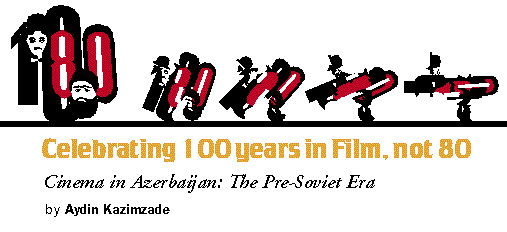 Up until last year, film historians
thought the first movie produced in Azerbaijan dated back to
1916 with Svetlov's movie, "In the Realm of Oil and Millions."
Then Aydin Kazimzade discovered a small newspaper announcement
in the archives of the Lenin Library in Moscow, providing evidence
that film in Azerbaijan really dates back nearly 20 years earlier
to 1898. Instead of being a latecomer to the fascinating world
of cinematography, Azerbaijan was, indeed, among the first countries
involved. Last year, Azerbaijan celebrated 80 years of cinematography;
next year, because of this new historical proof, they'll celebrate
100! Up until last year, film historians
thought the first movie produced in Azerbaijan dated back to
1916 with Svetlov's movie, "In the Realm of Oil and Millions."
Then Aydin Kazimzade discovered a small newspaper announcement
in the archives of the Lenin Library in Moscow, providing evidence
that film in Azerbaijan really dates back nearly 20 years earlier
to 1898. Instead of being a latecomer to the fascinating world
of cinematography, Azerbaijan was, indeed, among the first countries
involved. Last year, Azerbaijan celebrated 80 years of cinematography;
next year, because of this new historical proof, they'll celebrate
100!
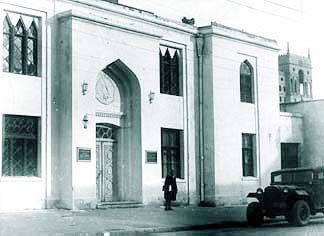  Left: The first film studio in Baku established
in the 1920s. The location of the studio was behind the Government
Building. It no longer exists. Left: The first film studio in Baku established
in the 1920s. The location of the studio was behind the Government
Building. It no longer exists.
When the Lumière brothers of France premiered their
first motion picture footage in Paris on December 28, 1895, little
did they know how rapidly it would capture the imagination of
the public and ignite a new age of photographic documentation.
Nor did they know that their invention would usher in one of
the most creative art forms ever known to mankind which would
document, while at the same time shape, the history of mankind.
These ingenuous brothers, Auguste (1862-1954) and Louis (1864-1948)
invented an apparatus, patented in February 1895, which they
called the "Cinematographe" (and from which is derived
the word, "cinematography"). Their apparatus, doubling
as a early motion-picture camera and as a projector, borrowed
heavily from Thomas Edison's "Kinetoscope" and Emile
Reynauld's "Theatre Optique."
The Lumière brothers'
film, shown publicly for the first in 1895, is recognized as
the first movie ever made. Rather mundane in nature, its title
was "La Sortie des Usines Lumière" (Lunch Break
at the Lumière Factory). It was first shown at the Grand
Café on the Capucines Boulevard in Paris. Immediately,
the concept for motion pictures swept beyond the borders of France.
It's not surprising that this
apparatus soon showed up in Baku. At the turn of the 19th century,
this bay town on the Caspian was producing more than 50 percent
of the world's supply of oil. Just like today, the oil industry
attracted foreigners eager to invest and to work. The service
industry quickly followed on the heels of the oil industry.
The Film Footage in
Baku
And so a Frenchman by the name of A. Mishon was among those entrepreneurs
who came and settled in Baku. A photographer and cameraman by
profession, he is believed to have lived in Baku for more than
25 years where he set up a photo studio on Mikhailovski Street,
now known as Aziz Aliyev Street.
Mishon became active in forming
a scientific photo circle in Baku and became its secretary. From
1879 to 1905, he documented landscapes, episodes from oil extraction,
the refining process, as well as the oil gushers eruptions and
terrifying fires that broke out in the oil fields. Copies of
his photos still exist today.
In 1898, Mishon began shooting
motion pictures that depicted everyday life in Baku. It was his
intention to exhibit them in Paris, but prior to that, he organized
a showing in Baku. The "Kaspi" newspaper announced
his film on August 1, 1898. It read as follows:
The Newspaper Announcement
"On Sunday, August 2, 1898, A. Mishon, will show some motion
pictures that he has taken with a Lumière movie camera
and which has been improved by the engineer Jules Carpentier.
These films of the Caucasus and Central Asia have been prepared
for the forthcoming International Paris Exhibition and will be
presented only once in Baku at the V. I. Vasilyev-Vyatski Circus
Theater.
"The following films will
be shown: Fire resulting from an oil gusher at Bibi-Heybat oil
field, the departure ceremony of His Excellency Amir of Bukhara
(now Uzbekistan) in the Grand Duke Alexei steamship, a folk dance
of the Caucasus, and scenes from the comedy, 'So, You Got Caught,'
which was performed recently in one of Baku's parks. For more
detailed information, see the posters. The event starts at 21:00
(9 p.m.)."
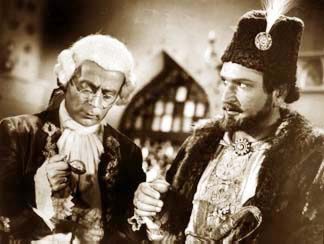  Needless to say, the event was an enormous
success and Mishon repeated it on August 5, replacing the final
two works with those showing life in Balakhani outside of Baku. Needless to say, the event was an enormous
success and Mishon repeated it on August 5, replacing the final
two works with those showing life in Balakhani outside of Baku.
Left:
From "Fatali Khan,"
1947. Movie depicts the struggle to unite separate khanates into
one united Azerbaijan. Right, Fatali Khan (Alasgar Alakbarov)
speaking to an emissary from Russia.
Mishon's films obviously made an impact at the Paris Exhibition.
They must have attracted more foreigners to the oil-booming town.
Reference was made, rather jokingly to these films in a play
entitled, "Oil Gusher" written by the Azerbaijani poet
Abbas Sahhat (1874-1918) and staged in Baku. The hero of the
play comments that when he saw the films at the Paris Exhibition,
he immediately set about to come to Baku to find a job. But he
complains that when he arrived, Balakhani which had seemed so
beautiful in the film was in reality such a run-down place. In
the play, he laments, "I came here, found a job, got a position.
But, now, how am I supposed to live in the midst of all this
dirt, dust, mud and fumes?"
Mishon's footage still exists.
"Folk Dance of the Caucasus" was later used in a documentary
and scenes from "Oil Gush Fire in Bibi-Heybat" were
shown in France
in 1995, in a film commemorating the 100th anniversary of world
cinema. On November 27,
1899, an article entitled: "Implementation of New Inventions"
was published in the "Kaspi" newspaper, written by
Hasan Zardabi, writer, scientist and social activist. He observed,
"Now we have in our hands a toy machine-called "kinemato-graphe."
This wonderful machine was produced only a short time ago and
gives the impression of being just a toy. You can find this machine
which is called 'stroboscope' in many optician shops."
This fact would indicate the
early replicas of this first Azerbaijani apparatus-stroboscopes-were
being sold in Baku at the turn of the last century.
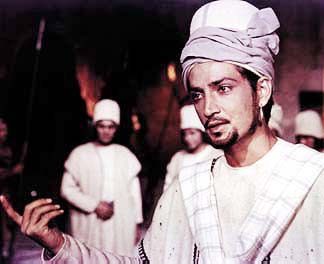  Cinematography Evolves Cinematography Evolves
Between 1907-1910, archival
footage indicates that Mr. V. Amashukeli, one of the founders
of the Georgian cinematography, produced footage dealing with
life in Baku "Types of Baku Markets," "Strolling
along the Seashore" and "Work on Oil Rigs."
Left: Rasim Balayev as Nasimi, the famous
poet, in the movie by the same name, produced by Hasan Seyidbeyli
in 1974.
In 1915 the Pirone brothers
of Belgium set up a film production laboratory in Baku. They
invited film director Svetlov from St. Petersburg to work for
them and produce "The Woman," "An Hour before
His Death" and "An Old Story in a New Manner."
It was Svetlov who also directed the film entitled "In the
Realm of Oil and Millions" which later became so well known.
The famous Azerbaijani actor Husein Arablinski played Lutfali,
the main role in this film.
In 1917, a documentary entitled
"National Freedom Holiday in Baku" was made. The film
includes footage taken of the central square of Baku, its streets,
avenues, parks and the seashore.
In 1919 during the short-lived
independence of the first Azerbaijan Democratic Republic, a documentary
called "The First Anniversary of the Musavat Power in Azerbaijan"
was made. Filmed on Azerbaijan's Independence Day, May 28, this
chronicle premiered in June at several cinema houses such as
"Express," "Record," and "Forum."
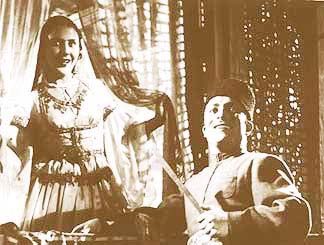  Arshin Mal Alan-"The Cloth
Peddler" Arshin Mal Alan-"The Cloth
Peddler"
Left: From the 1945 version of "Cloth
Peddler" (Arshin Mal Alan) based on the musical comedy by
Uzeyir Hajibeyov. It won the Stalin Prize. Leila Badirbeyli plays
Gulchohra.
The first version of the operetta "Arshin Mal Alan"
was directed by Svetlov in 1916. Since this was still the era
of "silent" film, the musical selections had to be
performed by in-house musicians. Furthermore, as this was still
early in the era of theater, two of the women's roles in the
film were played by men. Gulchohra was played by Ahmad Aghdamski
and Aunt Jahan was played by Y. Narimanov. The other women's
roles were played by Russians, not Azerbaijanis, who at that
time mostly remained traditionally secluded and veiled. A. Olenskaya
played Asya and Y. Olenskaya played Telli.
Despite their efforts, the quality of the film did not satisfy
Uzeyir Hajibeyov, who had written the original operetta (1910).
However, the audience watched with great interest. An article
in the "Sovgat" (Present) newspaper on January 17,
1917, noted that it would have been much easier to have found
a ticket for a Shalyapin concert than for this film.
A second version of "Arshin
Mal Alan" was produced in 1917 by G. Belyakov from St. Petersburg.
Belyakov did not ask Hajibeyov's permission to make a film. Nor
were there any backdrops or stage settings. All the scenes were
filmed in courtyards of houses and in the "Forum" cinema
house. The only backdrop that Belyakov used was carpets which
he thought made the film distinctly Azerbaijani. All the actors
were amateurs. As the quality of the film ended up being so poor,
Hajibeyov eventually managed to pull it out of circulation.
Despite all these simple beginnings,
cinema had taken root. There were no film studios in the beginning.
Nor was there any systematic cinematic technique. Nevertheless,
it's evident that people were passionately enthusiastic about
film from its earliest beginning.
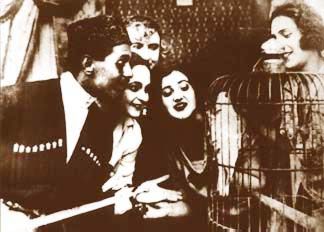  The Soviet Period The Soviet Period
Left: From "In the Name of God"
(Bismillah), 1925. Directed by Abbas Mirza Sharifzade. It exposed
the criminal activities of fake clergy.
After the Soviet power
was established in 1920, Nariman Narimanov, Chairman of the Revolutionary
Committee of Azer-baijan, signed a decree nationalizing Azerbaijan's
cinema. The People's Education Commissariat, which functioned
somewhat like a Ministry, created an art department which included
a film section headed by Hanafi Teregulov and Muslim Magomayev,
a notable composer and opera singer. In 1922 the government of
Azerbaijan decided to create the first cinema factory which became
the forerunner of today's film studio "Azerbaijanfilm."
In 1923 the Azerbaijan Photo Film Institution (APFI) was established
by a special decree of the Council of People's Commissars. The
Institution controlled all the movie houses and distribution
bureaus. The institute was built on the premises of what had
been a fashionable restaurant, "The Renais-sance,"
prior to the Revolution. It opened on April 28, 1923. And thus,
a new epoch in the history of Azerbaijani cinema began-a period
when Soviet ideology, not individual entrepreneurship, dominated
the film industry.
Now more than 70 years later, Azerbaijani filmmakers are again
dealing with issues similar to those faced by cinematographers
prior to the establishment of the Soviet Union in 1920. Once
again, both choice of content and sponsorship of films are largely
left up to the initiative of the filmmaker.
Aydin Kazimzade is Director
of Azerbaijan's Cinema Museum and Assistant Editor of the Encyclopedia
of Azerbaijani Cinema.
From
Azerbaijan
International
(5.3) Autumn 1997.
© Azerbaijan International 1997. All rights reserved.
Back to Index
AI 5.3 (Autumn 1997)
AI Home | Magazine
Choice
| Topics
| Store
| Contact
us
|

 Up until last year, film historians
thought the first movie produced in Azerbaijan dated back to
1916 with Svetlov's movie, "In the Realm of Oil and Millions."
Then Aydin Kazimzade discovered a small newspaper announcement
in the archives of the Lenin Library in Moscow, providing evidence
that film in Azerbaijan really dates back nearly 20 years earlier
to 1898. Instead of being a latecomer to the fascinating world
of cinematography, Azerbaijan was, indeed, among the first countries
involved. Last year, Azerbaijan celebrated 80 years of cinematography;
next year, because of this new historical proof, they'll celebrate
100!
Up until last year, film historians
thought the first movie produced in Azerbaijan dated back to
1916 with Svetlov's movie, "In the Realm of Oil and Millions."
Then Aydin Kazimzade discovered a small newspaper announcement
in the archives of the Lenin Library in Moscow, providing evidence
that film in Azerbaijan really dates back nearly 20 years earlier
to 1898. Instead of being a latecomer to the fascinating world
of cinematography, Azerbaijan was, indeed, among the first countries
involved. Last year, Azerbaijan celebrated 80 years of cinematography;
next year, because of this new historical proof, they'll celebrate
100!



